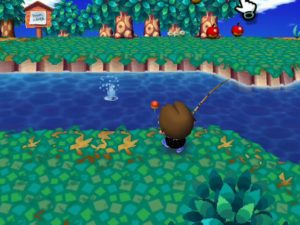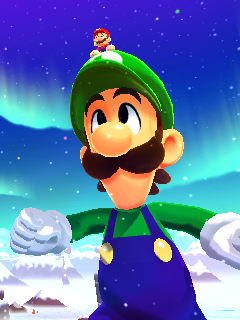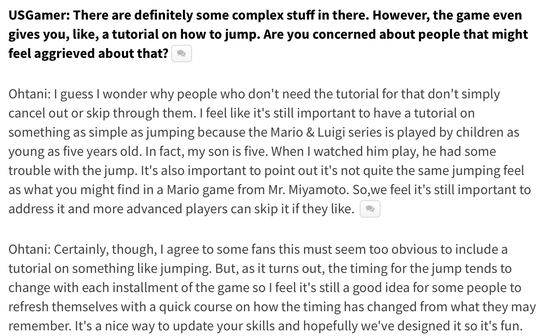Animal Crossing – The Hooks of a Social Simulation
May 30th, 2018
The Animal Crossing games have a unique talent of engaging player interest over a sustained period of time. However, the titles don’t rely on the traditional challenge-skill-reward loop of most video games. Rather, the genius of Animal Crossing is in how it uses systems of the everyday to draw the player into its social simulation.
Time Cycle
Animal Crossing‘s game world reveals itself over time as the internal clock (in conjunction with other measures and timers) triggers a host of behaviours and scenarios. These include, but are not limited to:
-
Weather patterns;
-
The presence of flowers, fruit, fish, insects, and fossils;
-
The coming and going of your neighbours;
-
Festivals;
-
The dialogue of individual characters;
-
The availability of products;
-
Access to the general store.
The player’s response (or lack of response) to each time window ripples forward through the game world. Chat with your neighbours regularly and they’ll be more inclined to remain in the village. Forget to check in on your town for a month and it’ll become infested with weeds. The time cycle encourages the player to play a little each day over an extended duration of time to maintain the smooth running of the village.
Game World
Animal Crossing is set within the confines of your reasonably small village. The size of the game world, in combination with its Truman Show-esque clockwork of daily activity, emphasises the small, evolving details (what *insert favourite animal friend* is going to say today, the new item on sale at Tom Nook’s store, the growing of a sapling into a tree, etc).
The Hooks
The time cycle and compact size of the township facilitate the social sim’s first hook—the characters. By virtue of the player moving around the confined space of the village and the characters going about their daily routines, the player is likely to stumble upon the animal characters and, in good odds, talk to them. Your neighbours are, after all, the most dynamic and interactive game element in town. Even if players choose to ignore the population of zoo creatures, their furry friends will occasionally run over to ask a question or dispel of some random thought bubble or throwaway piece of furniture. Tom Nook’s initial errands also set a precedence by sending the player out to interact with potential customers and chase debts. Needless to say, your animal friends are pretty hard to avoid.
It’s through the process of regularly seeing and interacting with your neighbours that you come to form an affection for them, not unlike real life. This affection is helped along in great part by the incredible localisation which makes each personality larger than life. The animals will call you a friend, give you nicknames, spout out their own personalised catch phrases, and share their obscure and funny musings on the world around them. They’re engineered to be loved.
The second hook can be explained much more simply: customisation. The Animal Crossing games present the player with a wealth of customisation options. The player can modify the avatar’s name, hair style, clothes, house, furniture, wallpaper, flooring, and the name of the village. Once the foundation is laid, new opportunities for creative ownership arise in the form of the animal characters asking the player for opinions, catch phrases, and secret best friend codes. The power of customisation is that it gives the player a sense of ownership over the game world because it asks that they invest some of their creative energy into shaping the fictional environment.
The phenomenon described above is similar in nature to the third hook: player agency. As mentioned previously, many of the player actions ripple forward through time and your town thereby becomes a collective representation of your individual experiences. The more you play and the more of yourself you invest into the game world, the more of that investment is reflected back at you through gameplay.
Conclusion
Animal Crossing‘s real-world time cycle encourages the player to play the game regularly over an extended period of time. The small size of each village makes it difficult to avoid the population of animal characters going about their daily routines. It’s the frequent interactions with these characters as well as the many opportunities to customise and affect the game world which allow the player to be drawn into Animal Crossing‘s social simulation.
Mario and Luigi: Dream Team Bros. – Remaining Thoughts
May 7th, 2018
To close this series of posts on Mario and Luigi: Dream Team Bros., I’ve compiled a few smaller thoughts into this one article. For more on Mario and Luigi: Dream Team Bros., look forward to the (eventual) first issue of Adventures in Games Analysis where I explore how AlphaDream leveraged the 3DS hardware to evolve the Mario and Luigi battle system.
Wiggle Room in Combat Feedback
Depending on how well the player performs an attack, the words “Excellent”, “Great”, “Okay”, or “Miss” will appear on screen as a form of feedback. All “Excellent” Bros attacks net the same amount of damage no matter if the player executes the sequence quickly, slowly, with perfect accuracy, or perhaps with a minor mistake. Given the wiggle room within each bracket, it would have been nice if the damage count more accurately reflected the player’s performance. For example, I always challenge myself to complete Bomb Derby as quickly as possible, yet there’s no difference between a successful slow run and a successful fast run, although the former demands more skill. Tweaking the damage count as suggested would add a barely noticeable layer of complexity to the combat and increase the skill ceiling for more savvy players like myself.
Expert Challenges
Expert challenges are player goals built into the combat system. These optional objectives increase the skill ceiling of the game and provide a means for keeping advanced players more engaged, if indeed they choose to pursue such objectives. On completing each challenge, the player is rewarded with points which lead to special equipment once set tallies are reached.
It’s a fabulous system marred somewhat by an uninspired set of objectives. Of the 111 challenges, 61 involve the player finishing a battle with a particular enemy without getting hit, 34 involve performing excellent attacks either with a particular mechanic or for 10 times in a particular location, and 16 involve dodging 10 enemies in a row in a particular location (full list here).
The objectives blur together under the mantra of “play good”, when perhaps they could have been used to encourage the player to explore more of the design space. Think the Hooraw Beef-off battles where the player is challenged to defeat four bosses under special conditions, but extended to cover the main game. A flashing prompt on the touch screen could inform the player of when such challenges become available. With a quick tap, they could then enter into these alternative battles. Personally, I would find this tailored form of branching difficulty much more attractive than an extra difficulty select where enemy values are arbitrarily increased.
Gyro Prompt
In the pre-attack screen preceding Bros and Luiginary Attacks, the 3DS’s gyro sets the position by which all later gyro movements will be anchored around (much in same way the analog stick is calibrated). The calibration becomes apparent the first time you start one of these attacks while holding your 3DS at an awkward angle, which you must then pivot around for the subsequent sequence. Thus, the pre-attack screen also acts a reminder to hold your 3DS in a neutral position.
Tutorials
Many of the Dream Team Bros. reviews complained about the game’s supposed heavy handed tutorials. Let’s put the number of tutorials into perspective for a moment. The introduction sequence before the Bros. arrive at Mushrise Park features a lot of needless chatter that doesn’t function very well as tutorial or story (the quiz and jumping mini-game come to mind). Afterwards, there’s a few important tutorials on the core mechanics, and then you’re left to your own devices until you acquire the next new ability. With each new mechanic added to the Bros.’s ability set, Starlow spends 1-2 minutes introducing the new move. So across the forty-hour adventure, the player probably has less than an hour of tutorial time, most of which they can skip if they choose. The anti-tutorial sentiment simply doesn’t stand up to basic scrutiny.
Producer Akira Ohtani’s response (responses?) to this interview question bemoaning tutorials in Dream Team Bros. explains the situation well. AlphaDream, as with most developers, want their work to reach as wide an audience as possible and tutorials enable them to cater to players of a variety of ages and skill levels.
Mario and Luigi: Dream Team Bros. – Where Skilful Play Ends
May 4th, 2018
Within games criticism exists a niche subset of “challenge-run” criticism where a player will attempt to beat a game while adhering to a set of self-imposed rules. These rules—such as, not firing a bullet or trying to beat the game on one life—act as a prism through which the player can then critique the game. Personally, I’m not a fan of this form of criticism, but I have started using some of the techniques to help me become a better player and hence a more insightful writer. For example, last year I beat The Legend of Zelda: Skyward Sword with only three hearts in order to better understand the motion-based combat.
Given my dislike of levelling and equipment systems in the Mario and Luigi games, I played Mario and Luigi: Dream Team Bros. underleveled and paid little attention to the equipment system. As with Bowser’s Inside Story, I used the badge system as a means to top up my SP so that I had more opportunities to master the Bros. and Luiginary Attacks. These decisions, I believe, allowed me to play a more skilful game and better understand the core actions of the combat system.
“Challenge runs” usually bring a particular aspect of a game into focus, and for Dream Team Bros. my more skill-based approach left me unprepared to tackle the game’s surprising number of difficulty spikes. Friend and regular commenter on the Daniel Primed blog, CM30 covered the worst offenders in his piece Opinion; Mario & Luigi Dream Team’s Toughest Bosses, so I’ll let his words do the legwork here. Given AlphaDream’s attempt to make the series more approachable to a wider audience, this issue stands out as a major oversight. Fortunately, I could overcome most of the difficulty spikes thanks to gold ol’ fashion attacking and dodging—and a long view towards winning the war of attrition. However, my earnest attempts were no match for Dream Team Bros.‘s final boss Dreamy Bowser.
The confrontation is simply rigged. Initially at least, the gaudy-coloured tyrant plays out like most other boss battles. However, after the first few turns Bowser then withdraws into the background to chow down on a magically spawned pile of meat, curing around 500 HP across him body and arms. Each turn another pile of meat drops out of thin air and Bowser’s mid-battle snack continues while the player is left strong-arm their way through an army of technicoloured goons. Even if the player uses a taunt ball on their next turn to lure Bowser back into the foreground (an already somewhat nuanced move), Bowser will have already recovered a significant amount of damage. And so the war of attrition rages.
The biggest problem with this battle is the difficulty of Bowser’s attacks and the protracted learning process it takes to learn the tells. Each individual attack is actually a sequence of smaller attacks which run over a continuous period of time, and Bowser will usually attack more than once per turn. Furthermore, since one mistake can throw off the timing needed to stay in sync with the sequence, individual hits can quickly snowball. When this happens, the player needs to heal, in turn conceding an opportunity for Bowser to heal as well. If one of the Bros. is knocked out, then the player must forfeit the entire turn in order to reconsolidate. So the player must avoid most attacks or struggle against the slippery slope.
From my experience, the war of attrition rages for about 10 minutes before Bowser’s HP drops to where he’ll start using his strongest attacks. However, should the player fail to adequately respond to Bowser’s new moves (which they likely will as they need time to learn and encode the new attacks into memory), then they’ll have to spend another 10 minutes in the trenches. Hence, the process of mastering Bowser’s later attacks is highly protracted.
My “challenge run” had taught me that playing Mario and Luigi: Dream Team Bros. as a purely skill-based game with little investment in the levelling and equipment systems has its limits. In this case, Dreamy Bowser is the point where player skill no longer translates into success in the combat system.
Postscript
After struggling against Dreamy Bowser for several hours and ready to put Dream Team Bros. on the shelf, I was airing my grievances with CM30 when he gave me a tip. He suggested that I equip the Miracle and Gold badges, grind up some badge meter, and use their power to freeze Bowser for a few turns. This way I could squeeze in one more attack per turn and finish him off before he entered into his meat-eating recovery state. And it worked! Within 5 minutes I had Bowser beat (CM30 did it in three!). So maybe skill wins after all!
Additional Readings






 Game Design Companion: A Critical Analysis of Wario Land 4 - $7.99
Game Design Companion: A Critical Analysis of Wario Land 4 - $7.99 Level Design: Processes and Experiences
Level Design: Processes and Experiences Speed Boost: The Hidden Secrets Behind Arcade Racing Design - $5.99
Speed Boost: The Hidden Secrets Behind Arcade Racing Design - $5.99 Adventures in Games Analysis: Volume I - $5.99
Adventures in Games Analysis: Volume I - $5.99







